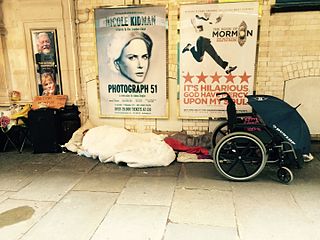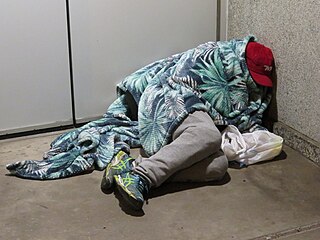Related Research Articles

This article is about the demographic features of the population of the Netherlands, including population density, ethnicity, education level, health of the population, economic status, religious affiliations and other aspects of the population.

Homeless shelters are a type of homeless service agency which provide temporary residence for homeless individuals and families. Shelters exist to provide residents with safety and protection from exposure to the weather while simultaneously reducing the environmental impact on the community. They are similar to, but distinguishable from, various types of emergency shelters, which are typically operated for specific circumstances and populations—fleeing natural disasters or abusive social circumstances. Extreme weather conditions create problems similar to disaster management scenarios, and are handled with warming centers, which typically operate for short durations during adverse weather.

In England, local authorities have duties to homeless people under Part VII of the Housing Act 1996 as amended by the Homelessness Act 2002. There are five hurdles which a homeless person must overcome in order to qualify as statutory homeless. If an applicant only meets the first three of these tests Councils still have a duty to provide interim accommodation. However an applicant must satisfy all five for a Council to have to give an applicant "reasonable preference" on the social housing register. Even if a person passes these five tests councils have the ability to use the private rented sector to end their duty to a homeless person.
Turks in the Netherlands refers to people of full or partial Turkish ethnicity living in the Netherlands. They form the largest ethnic minority group in the country; thus, the Turks are the second-largest ethnic group in the Netherlands after the ethnic Dutch. The majority of Dutch Turks descend from the Republic of Turkey; however, there has also been significant Turkish migration waves from other post-Ottoman countries including ethnic Turkish communities which have come to the Netherlands from the Balkans, the island of Cyprus, as well as from other parts of the Levant. More recently, during the European migrant crisis significant waves of Turkish minorities from Syria and Kosovo have also arrived in the Netherlands. In addition, there has been migration to the Netherlands from the Turkish diaspora; many Turkish-Belgians and Turkish-Germans have arrived in the country as Belgian and German citizens.

Homelessness in the United Kingdom is measured and responded to in differing ways in England, Scotland, Wales and Northern Ireland but affects people living in every part of the UK's constituent countries.

Homelessness or houselessness – also known as a state of being unhoused or unsheltered – is the condition of lacking stable, safe, and functional housing. People can be categorized as homeless if they are:
Chinese people in the Netherlands form one of the largest overseas Chinese populations in continental Europe. In 2018 official statistics showed 92,644 people originating from the People's Republic of China (PRC) and Republic of China (ROC), or people with at least one such parent. However, these statistics do not capture the whole size of the Chinese community, which since its earliest days has included not just migrants from China, but people of Chinese ethnicity drawn from among overseas Chinese communities as well.
Indians in the Netherlands are residents of Indian origin in the Netherlands. The majority of the people of Indian descent in the Netherlands are of Indo-Surinamese origin. More recently the flow of emigrants from India has increased, especially information technology professionals.

The adoption of plug-in electric vehicles in the Netherlands is actively supported by the Dutch government through the exemption of the registration fee and road taxes. These purchase incentives have been adjusted over time. Considering the potential of plug-in electric vehicles in the country due to its relative small size and geography, the Dutch government set a target of 15,000 to 20,000 electric vehicles with three or more wheels on the roads in 2015; 200,000 vehicles in 2020; and 1 million vehicles in 2025. The first two targets were achieved two years earlier than planned.

The San Francisco Bay Area comprises nine northern California counties and contains four of the ten most expensive counties in the United States. Strong economic growth has created hundreds of thousands of new jobs, but coupled with severe restrictions on building new housing units, it has resulted in an extreme housing shortage which has driven rents to extremely high levels. The Sacramento Bee notes that large cities like San Francisco and Los Angeles both attribute their recent increases in homeless people to the housing shortage, with the result that homelessness in California overall has increased by 15% from 2015 to 2017. In September 2019, the Council of Economic Advisers released a report in which they stated that deregulation of the housing markets would reduce homelessness in some of the most constrained markets by estimates of 54% in San Francisco, 40 percent in Los Angeles, and 38 percent in San Diego, because rents would fall by 55 percent, 41 percent, and 39 percent respectively. In San Francisco, a minimum wage worker would have to work approximately 4.7 full-time jobs to be able to spend less than 30% of their income on renting a two-bedroom apartment.
Homelessness in Denmark is considered a significant social issue in the country. Since 2007, comprehensive counts have been performed every other year in week six. The latest, from 2017, counted 6,635 homeless people in Denmark. The total number of people experiencing homelessness at some point in 2017 was estimated at 13,000, while earlier estimates have placed it between 10,000 and 15,000. Roughly half the homeless are in the Capital Region. When compared to many other countries, such as the United States, the rate of Denmark's homeless is significantly lower, which has been linked to the relatively comprehensive welfare system.
Homelessness in Germany is a significant social issue, one that is estimated to affect around 678,000 people. Since 2014, there has been a 150% increase in the homeless population within the country due to the inclusion of refugees. Reportedly, around 22,000 of the homeless population are children.
Homelessness in Greece refers to the state or process of sleeping in housing that is below the minimum standard or lacking secure tenure, in relation to the nation of Greece. Austerity measures and the ongoing fiscal crisis have significantly spurred the rise in homelessness in Greece in the 21st century. Instances of homelessness have been dominantly concentrated in the city of Athens. Homelessness remains a relatively under-examined area of social policy in Greece, with the first organised counting for homeless people taking place in May 2018. Governments and non-profit organisations alike have made efforts to counter this phenomenon.

Homelessness in Florida is considered a major social issue, mainly due to its warm weather.

Homelessness in the United States has occurred to varying degrees across the country. The total number of homeless people in the United States fluctuates and constantly changes hence a comprehensive figure encompassing the entire nation is not issued since counts from independent shelter providers and statistics managed by the United States Department of Housing and Urban Development vary greatly. Federal HUD counts hover annually at around 500,000 people. Point-in-time counts are also vague measures of homeless populations and are not a precise and definitive indicator for the total number of cases, which may differ in both directions up or down. The most recent figure for the year 2019 that was given was at 567,715 individuals across the country that have experienced homelessness at a point in time during this period.

Homelessness is a growing problem in Colorado and is considered the most important social determinants of health. Homelessness is very difficult for many Coloradoans to escape due to the continuous increase in costs for housing in Colorado along with mental health treatments and other factors. When people are forced to live without stable shelter, they are then exposed to a number of risk factors that affect physical and mental health. Although it is difficult to pin point any one cause of homelessness, there is a complicated combination of societal and individual causes.

The United States Department of Housing and Urban Development estimated that more than 171,500 people were experiencing homelessness in California in January 2022. This represents 30% of the homeless population of the United States. More than two-thirds of homeless people in California are unsheltered, which is the highest percentage of any state in the United States. Half of the unsheltered homeless people in the United States live in California: about 115,500 people, which is nine times as many as the state with the second highest total.

Homelessness is a serious issue throughout the state of New Mexico. Through a demographic examination it becomes evident that New Mexico has a high proportion of ethnographies that are currently and historically socioeconomically disadvantaged. Native Americans as a proportion of the US population represent the second highest amongst all States with only Alaska having a higher ratio, while it also has a large Hispanic population. Homelessness is a direct cause from an individual not being able to provide themselves with the most basic of necessities to maintain a healthy life hence having a higher proportion of individuals in poverty places a greater risk of an individual becoming homeless.

The COVID-19 pandemic in the Netherlands has resulted in 8,610,372 confirmed cases of COVID-19 and 22,992 deaths.

Martin v. Boise was a 2018 decision by the U.S. Court of Appeals for the Ninth Circuit in response to a 2009 lawsuit by six homeless plaintiffs against the city of Boise, Idaho regarding the city's anti-camping ordinance. The ruling held that cities cannot enforce anti-camping ordinances if they do not have enough homeless shelter beds available for their homeless population. It did not necessarily mean a city cannot enforce any restrictions on camping on public property.
References
- ↑ "Aantal daklozen in Nederland in tien jaar tijd ruim verdubbeld". NRC.
- ↑ "Daklozen". CBS.
- 1 2 3 "Veel meer daklozen in Nederland".
- ↑ "Steeds meer jonge daklozen in Nederland".
- ↑ "Aantal daklozen sinds 2009 meer dan verdubbeld".
- ↑ "Leger des Heils Nachtopvang voor dak- en thuisloze mensen". www.legerdesheils.nl.
- 1 2 "De nachtopvang is rustig, de straat loopt vol".